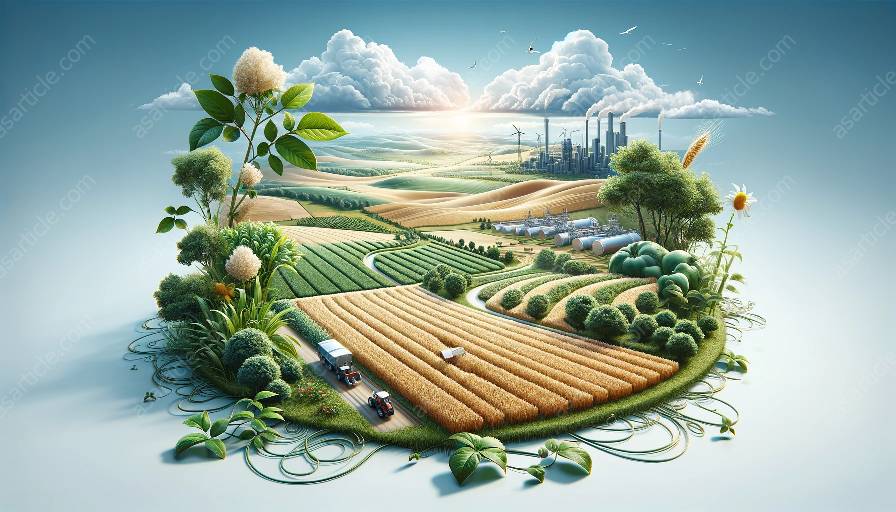The geology of agricultural landscapes plays a crucial role in shaping the environment in which farming and agriculture take place. This interplay between geology and agriculture falls within the interdisciplinary scope of agricultural geology, which seeks to understand and optimize agricultural practices in relation to the Earth's geological features. In this comprehensive exploration, we will delve into the various aspects of the geology of agricultural landscapes and its significance to both agricultural geology and agricultural sciences.
Understanding Geological Processes
Geological processes have been instrumental in shaping the physical landscape of agricultural regions. From the formation of soils to the presence of mineral resources, the Earth's structure directly influences the suitability of land for farming and cultivation. Soil formation, for instance, is a complex process that is influenced by factors such as parent material, climate, topography, organisms, and time. Agricultural geologists and scientists analyze these processes to better understand the distribution of fertile soils and nutrient-rich environments.
Soil Composition and Fertility
One of the key areas where geology intersects with agricultural landscapes is in the study of soil composition and fertility. Different geological formations give rise to distinct soil types, each with its own set of characteristics and agricultural implications. For example, the presence of limestone can contribute to alkaline soils, while volcanic ash deposits may lead to fertile, well-draining loamy soils. Understanding the geological origins of soils provides valuable insights into the types of crops that can be effectively grown and the potential for agricultural productivity in specific areas.
Water Resources and Hydrogeology
The availability and quality of water resources are critical for agricultural sustainability. Geological factors such as aquifer properties, permeability of rock formations, and groundwater recharge rates significantly influence the hydrogeological conditions of agricultural landscapes. Agricultural geologists study these factors to develop strategies for sustainable water management, including groundwater extraction, irrigation practices, and land use planning, in order to ensure the efficient use of water resources for agricultural purposes.
Land Stability and Hazards
Geological hazards, such as landslides, subsidence, or soil erosion, can pose significant risks to agricultural landscapes. Understanding the geological processes that contribute to these hazards is essential for mitigating potential threats to agricultural activities. Agricultural geologists work to identify areas prone to these hazards and develop management plans to minimize their impact on agricultural productivity. Furthermore, the study of land stability in agricultural landscapes also involves assessing factors such as seismic activity and the potential for soil contamination from natural geological sources.
Impacts on Agricultural Productivity
The geology of agricultural landscapes directly impacts the productivity and sustainability of farming practices. Understanding the distribution of different geological formations and their associated soil types allows for tailored agricultural strategies, including crop selection, soil management techniques, and land use planning. By incorporating geological knowledge into agricultural practices, farmers and agricultural scientists can optimize the use of natural resources and minimize environmental impact, leading to improved agricultural productivity and long-term sustainability.
Geological Mapping and Site Characterization
Geological mapping and site characterization are essential components of agricultural geology. By mapping out the geological formations and soil types present in agricultural landscapes, scientists can provide valuable information for land use planning, identifying areas suitable for specific crops, and assessing the potential for geological hazards. This detailed understanding of the geological makeup of the landscape enables more informed decision-making in agricultural development and resource management.
Geophysical Techniques and Remote Sensing
Advancements in geophysical techniques and remote sensing technologies have vastly improved our ability to study agricultural landscapes from a geological perspective. Methods such as ground-penetrating radar, electromagnetic surveys, and satellite imagery provide valuable data on subsurface geological features, soil characteristics, and land use patterns. These tools enable agricultural geologists and scientists to better understand the underlying geological processes and make informed recommendations for optimizing agricultural activities based on the geological makeup of the landscape.
Challenges and Opportunities
The geology of agricultural landscapes presents both challenges and opportunities for agricultural geologists and scientists. As the global demand for food continues to rise, understanding the geological factors that influence agricultural productivity becomes increasingly important. Climate change, land degradation, and natural resource management are just a few of the complex issues that require the integration of geological knowledge into agricultural sciences to ensure sustainable food production for a growing population.
Sustainable Land Use and Conservation
Utilizing geological knowledge to promote sustainable land use and conservation practices is a key opportunity in agricultural geology. By understanding the long-term impacts of geological processes on agricultural landscapes, scientists can develop strategies for soil conservation, land rehabilitation, and the promotion of agroecological approaches that align with the natural geological features of the land. Balancing agricultural productivity with environmental conservation is essential, and agricultural geology plays a crucial role in achieving this balance.
Technological Innovations and Precision Agriculture
Technological innovations, such as precision agriculture and geospatial data analysis, offer new avenues for integrating geological knowledge into agricultural practices. By utilizing georeferenced data on soil properties, topography, and geological formations, farmers can implement precision agriculture techniques that optimize the use of resources, minimize input usage, and enhance crop yield. Agricultural scientists are leveraging geology-derived data to develop innovative solutions that maximize the potential of agricultural landscapes while minimizing environmental impact.
Conclusion
The geology of agricultural landscapes is an intricate and multifaceted domain that influences the sustainable development of agricultural regions. By comprehensively understanding the geological processes, soil composition, water resources, and hazards present in agricultural landscapes, agricultural geologists and scientists can provide valuable insights to optimize agricultural practices, minimize environmental impact, and ensure long-term food security. The dynamic interplay between geology, agricultural geology, and agricultural sciences underscores the significance of integrating geological knowledge into agricultural decision-making for a more resilient and productive agricultural sector.

